GOOD KÁ, BAD KÁ
There is so much money, time and skill invested in KÁ — the Cirque du Soleil mid-east, tribal-flavored spectacle at MGM in Las Vegas that you don’t want to say anything bad about it. The sheer grandeur and never-before-seen technical stagecraft eclipses one’s desire to note that this is, basically, a $200 million video game.
In fact, KÁ seems better suited as a 30-minute theme-park attraction than a 90-minute theatrical event. It’s as if Disney had released a blockbuster epic adventure movie and decided to showcase the best footage onstage at Disney World, where eschewing plot for pyrotechnics is the norm. (Can you believe it? There are fireworks on stage in KÁ). 30 minutes of KÁ would have been a thrill ride; at 90 minutes, we become so bombarded with mind-numbing imagery that our intellect begins to question what the hell is going on; with this excess hour of non-narrative acrobatics, we have time to examine its weaknesses.
Certainly this is the best cirque du soleil show in vegas for family, and no one will argue that KÁ is so magnificent at the start that your eyes will pop out of your head — the problem is, once your eyes pop out, it’s difficult to focus on what comes next.
What promises to be incredible storytelling begins after a very funny and thrilling pre-show. Then, a voiceover introduces us to Imperial Twins who are upon a Royal Barge that is taking them to a pageant in their honor. While on board, they are entertained by the court with a demonstration of Martial Arts, including Wushu and Capoeira (I have no idea what these are, but they were in the press notes). The Twins play a duet on flute as archers with flamed spears begin to gather on the post-and-beam structure, which extends from the stage well into the audience. The entire setting thus far is staggeringly beautiful, and it’s lovely to see a Cirque production using pageantry and martial arts to tell a story. (The voiceover, by the way, never returns.)
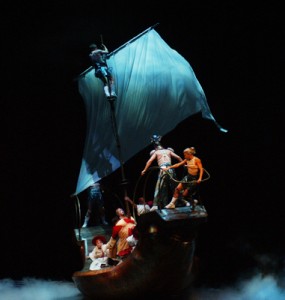 Suddenly, the barge is attacked by archers and spearmen who not only break up a swell party, but kill the Twins’ parents, who, I am pretty sure, paid for the shindig. At this point, although I’m mesmerized, it is clear there will be no dialogue; this bums me out because I have no idea who anybody is’”thank goodness for those press notes.
Suddenly, the barge is attacked by archers and spearmen who not only break up a swell party, but kill the Twins’ parents, who, I am pretty sure, paid for the shindig. At this point, although I’m mesmerized, it is clear there will be no dialogue; this bums me out because I have no idea who anybody is’”thank goodness for those press notes.
The Twin Sister is taken to another boat by her Nursemaid, leaving behind the injured brother. A massive storm begins and the Nursemaid falls from the boat, an 1800 pound structure that is completely manipulated by the artists onboard (again, information unknown to anyone without a press kit). Accompanied by haunting cello music by René Dupéré, the Twin Sister rescues her Nursemaid from the depths of the ocean’a moment that is filled with poignancy. Since the performers are harnessed, the illusion of being underwater is, no pun intended, breathtaking. Air bubbles are created through interactive video projections triggered by infrared sensors that react to the movement of the artists (you guessed it — the press kit).
Up to now, I’m giddy with excitement. Truly, you would be hard-pressed to find entertainment like this anywhere else in the world (speakers in each individual seat of the theater only enhance what we have seen so far). But it doesn’t take long for me to become disengaged. For next in the increasingly unclear goings-on, we are introduced to the reveling archers celebrating their victory. We have no idea who these villains are; they’re just stock bad guys. There is no writer credited, so it must have been creator and director Robert Lepage who decided that character development is clearly unimportant — although I’m sure that teenage boys will find that villainous bone-grinding contraption/thingy very cool. (I’m tired of looking at the press notes.)
Next, we are on a beach, where the Sister, Nursemaid and Valets are reunited. They encounter gargantuan, playful, silly sea creatures, including a starfish, crab, and some big, blue insect of some kind. Wait, back to the notes. Oh, a “curious blue potato bug.” No kidding.
Sure, the crab is funny, and the huge amount of sand sliding off the tilting stage is remarkable to watch, but the storytelling is lazy; in any great adventure, the friends that the heroes meet usually accompany them somehow on their journey. After we meet the playful crab (and grow an immediate fondness for the crustacean) the creature disappears, only to make a cursory appearance in the final scene.
What are we supposed to think when the Sister is rescued in another scene by “a fur-clad Mountain Tribe” with their “miraculous, man-powered flying machine.” After the sister plummets from the machine, a Firefly Boy (pictured below) catches her and they make a connection during a lengthy aerial duet while the Forest People bungee-jump around the forest. But his light proves to be too bright for her, and she ditches him to continue the search for her brother. (Too bad she didn’t have a large jar with holes punched in the top.)
The story of Imperial Twins finding their way back home and defeating the evil empire simply becomes an excuse to try out new gizardry (my word; a combo form of “gadgets” and “wizardry”). But why would anyone question the proceedings when you’re snowed under by this mega theater machine? (And, yes, there is snow.)
Why would anyone notice that the storytelling is convoluted when the stage can lift up and down, rotate 360 degrees, and tilt from flat to 110 degrees all at the same time?
How can you admit that your mind is wandering when 86 performers who work their internationally-toned butts off in 400 pairs of shoes (not to mention costumes that took 35,000 hours to produce) are executing acts of physical prowess that make the Olympics look like a walk in the park?
How can you say you are overwhelmed to the point of fatigue when 119 pyrotechnic devices, 120 fireballs, and 350 cubic feet of granular cork from Portugal (simulating sand) are thrillingly enhanced with 3,300 lighting fixtures and a sound system that weighs 43,868 pounds?
Why even notice that the 1,950-seat theater is so immense that you can barely make out the emotions on the actors’ faces knowing that the intricate detail of their make-up involves 33 steps, 8 brushes, 4 sponges, and 1 powder puff?
What is the point of acknowledging that the one scene which captivated us and touched our hearts was a simple display of shadow puppets when this hippodrome-sized production is one of the grandest ever staged?
Ultimately, the experience of KÃ is akin to the MGM resort itself: its behemoth opulence is amazing at first, but soon the myriad elements (shops, casinos, restaurants, fountains, theaters) become dizzying and off-putting; the mind has to shut down in order to take it all in, like an exceptional roller coaster that never ends.
photos by Tomas Muscionico
KA
Cirque du Soleil
MGM Grand
3799 S Las Vegas Blvd in Las Vegas
open run
for tickets, visit Cirque du Soleil/KA
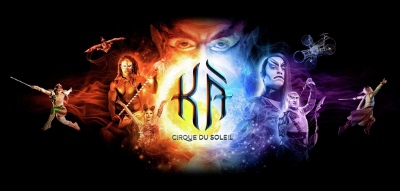

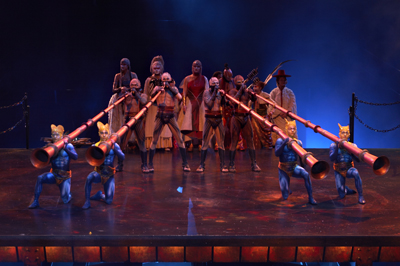
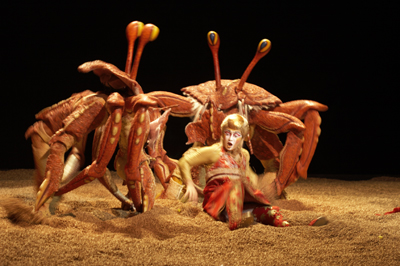

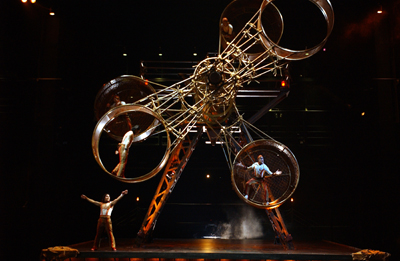
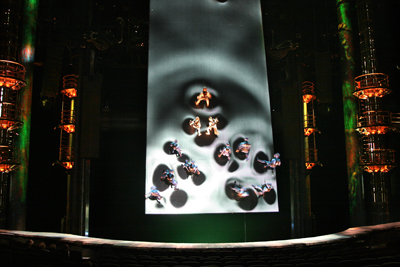

{ 3 comments… read them below or add one }
Con la presente vi chiedo dove posso trovare il dvd 3D KÀ la versione USA, nell’attesa porgo cordiali saluti.
I am not sure this is available, Stassi. Try Cirque du Soleil’s web site.
I saw this show when it was new, then again two years later. I saw that the original “battle on the poles” scene was gone. My understanding was that it was too dangerous to do daily. Then later I read that the “battle on the wall” finale was also gone because of a performer death. I have no idea how they could replace these two brilliant scenes with anything comparable, but anyway, I’m glad I was able to see the show as it was originally conceived. There’s always the “Best Of Cirque” movie, I suppose.